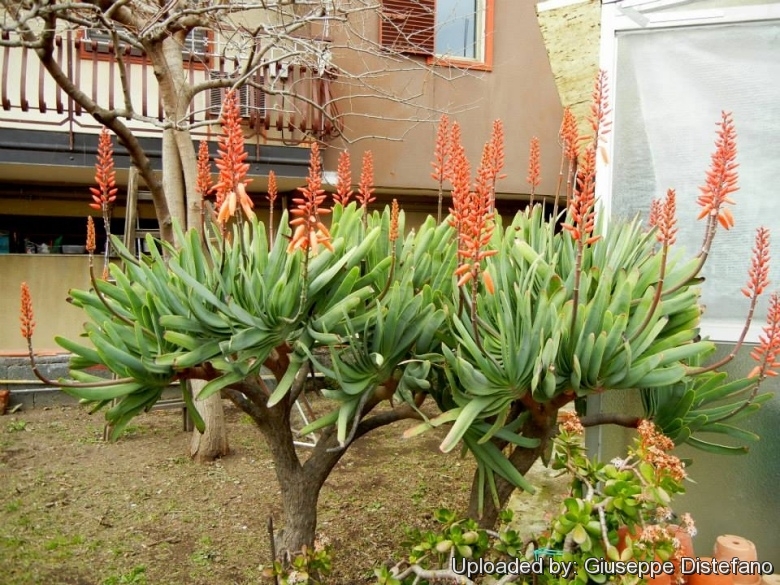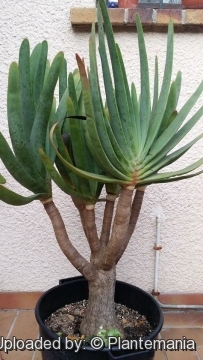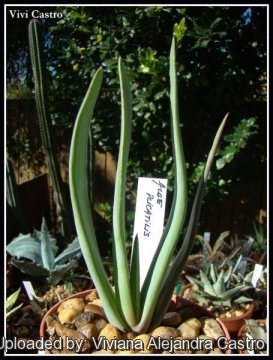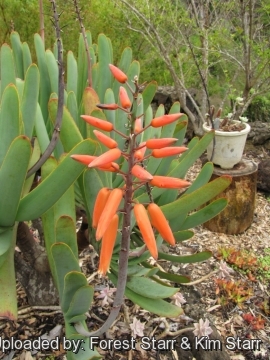
Kumara plicatilis Photo by: Giuseppe Distefano
Origin and Habitat: It is endemic to a few mountains in the Fynbos ecoregion between the town of Franschhoek and Elandskloof, Western Cape, South Africa South (Extent of occurrence 1800 km²)
Altitude: 150-650 metres above sea level.
Habitat: It is scattered in seventeen different populations and they can be fairly large, consisting of up to 500 mature individuals. It grows mostly on sandstone, and is often found on sandstone screes overlying granite in well-drained, sandy, slightly acidic soil on very steep, rocky, south-facing slopes that are protected from fire. The climate is Mediterranean with dry hot summers and cold wet winters. Other succulent plants found in this area comprises: Aloe commixta, and the rare sister species Aloe haemanthifolia. Invasive alien species, both due to escaping pine seedlings and other local invasives such as Australian acacias are present within the habitat, but these are either at too low densities to be causing any threat.
Synonyms:
See all synonyms of Kumara plicatilis
back
Accepted name in llifle Database:Kumara plicatilis (L.) G.D.RowleyAlsterworthia Int. Special Issue 10: 3 (2013)Synonymy: 11
back
Common Names include:
ENGLISH: Fan Aloe, Book-leaf Aloe, French Hoek Aloe
AFRIKAANS (Afrikaans): Kaapse Kokerboom (Cape Quivertree), Waaier Aalwyn (Fan Aloe), Bergaalwyn, Tongaalwyn, Waaieraalwyn, Bergaalwee, Franschhoekaalwee, Franschhoek-aalwyn, Waaier-aalwyn
FRENCH (Français): Aloés eventail
ITALIAN (Italiano): Aloe a ventaglio
RUSSIAN (Русский): Алоэ складчатое
Description: Kumara plicatilisSN|755]]SN|755]], best know as Aloe plicatilisSN|616]]SN|31628]], is a very distinct shrub-sized fan aloe with an incredibly architectural form. It is unique in appearance and looks like nothing else on earth. It's not similar to any other aloe and can take the form of a large bonsai with unusual and striking fan-like arrangement of its leaves. To the imaginative, the leaf-heads look a bit like a mass of grey hands, raised in the air.
Habit: It forms large multi-branched bush or, unusually for Aloe species, a small bonsai-like tree that grows slowly to a height and spread of 1 to 5 meters, but rarely reaches more than 2 m high in cultivation, and spreads somewhat wider.
Stem: Strong, sprawling with ends ascending branched dichotomously at short intervals, each growing point divides and keeps on subdividing, eventually creating a broad domed crown of leaf fans. The trunk has dun-brown papery skin and a corky, fire-resistant bark.
Rosettes: Dense, distichous, with leaves placed in a double row lying over each other and forming a flattened 'fan'
Leaves: 20-30 cm long, 4 cm wide, tongue shaped, linear or oblong-linear, compressed, pliable and ending obtusely rounded, sea green, glaucous, sometimes white-spotted. Margins entire with tiny teeth that are noticeable only on close inspection.
Inflorescence: Simple racemes up to 50-60 cm tall, flower-stalks, slender, about 1 cm in diameter, bracts about 8 mm long.
Flowers: Pendulous cylindrical 4,5-5,5 cm long orange-red to scarlet. the outer lobes united for more than half their length. Anthers and style exerted 1-5 mm.
Blooming time: Flowers appear at different times of the year, but mainly in winter.
Fruit: Loculicidal capsules, oval
Remarks: From a distance it may resemble in shape to a smaller Aloe dichotomaSN|31628]]SN|616]] for its dichotomous branching habit, but distinguish for the distichous arrangement of its linear leaves and straight perianth with the inner segments free so taxonomists have assigned it to its own separate genus Kumara.
Bibliography: Major references and further lectures
1) Urs Eggli “Illustrated Handbook of Suculent Plants: Monocotyledons” Springer, 2001.
2) Susan Carter, John J. Lavranos, Leonard E. Newton, Colin C. Walker “Aloes. The definitive guide” Kew Publishing, Royal Botanic Gardens, Kew 2011
3) Court, D, 1981. “Succulent flora of Southern Africa” Balkema, Cape Town.
4) 5) Germishuizen, G. & Meyer, N.L. (eds) 2003. “Plants of southern Africa : an annotated checklist.” Strelitzia 14. National Botanical Institute, Pretoria.
6) Jackson, W P U, 1990. “Origins and meanings of South African plant genera” UCT Ecolab, Cape Town.
7) Antje Burke “Wild flowers of the southern Namib” Namibia Scientific Society, 2003
8) Gordon D. Rowley “The illustrated encyclopedia of succulents” Crown Publishers, 01/Aug/1978
9) Leistner, O.A. 2005. “Seed plants of southern tropical Africa” SABONET, Pretoria.
10) Nichols, G. 2005. “Growing rare plants, a practical handbook on propagating the treatened plants of southern Africa” Southern African Botanical Diversity Network Report No. 36. SABONET, Pretoria .
11) Reynolds, G.W. 1950. “The aloes of South Africa” The Aloes of South Africa Book Fund, Johannesburg.
12) Van Jaarsveld, E., Van Wyk, B-E. & Smith, G. 2000. “Succulents of South Africa” Cape Town , Tafelberg
13) Van Wyk, A.E. & Smith, G. 2001. “Regions of floristic endemism.” Umdaus Press, Hatfield.
14) Williamson, G. 2000. “Richtersveld. The enchanted wilderness” Umdaus Press, Hatfield.
15) Hans Bornman, David S. Hardy “Aloes of the South African veld” Voortrekkerpers, 1971
16) Barbara Jeppe “South African aloes” Purnell, 1974
17) Ben-Erik Van Wyk, Gideon Smith “Guide to the Aloes of South Africa” Briza Publ., 1996
ISBN 1-875093-04-4
19) Stearn, W.T. 2003. “Stearn's dictionary of plant names for the gardener” Cassel, UK.
20) Smith, C.A. 1966. “Common names of South African plants.” Memoirs of the Botanical Survey of South Africa No. 35.
21) Van Wyk, B.-E. & Gericke, N. 2000. “People's plants. A guide to useful plants of southern Africa” Briza Publications, Pretoria.
22) Van Wyk, B-E. & Smith, G. 1996. “Guide to the aloes of South Africa” Briza Publications, Pretoria.
23) “Aloe gariepensis” Pillans in: South African Gardening and Country Life 23: 213 (1933a); Reynolds: 400 (1950); Jeppe: 32 (1969); Soldi, Roessler & Merxm.: 16 (1970); Bornman & D.S.Hardy: 217 (1972); I.Verd.: t. 1654 (1972); Jankowitz: 28 (1975); B.-E. van Wyk & G.F.Sm.: 172 (1996).
24) Walter C. Holmes & Heather L. White “Aloaceae in der Flora of Northern America” Volume 26, S. 410
25) John Wilkes (of Milland House, Sussex) “Encyclopaedia Londinensis, or, Universal dictionary of arts, sciences, and literature”, Volume 1 1810
26) Kristo Pienaar “South African 'What Flower Is That'?” Struik, 01/Aug/2003
27) Barbara Segall “Botanica: the illustrated A-Z of over 10,000 garden plants and how to cultivate them” Mynah, 1997
28) Sean. Hogan “Flora” Timber Press, 2003
29) Baker, J. G. “Flora Capensis” page 253 (1897)
30) Jackson, Benjamin, Daydon; “A Glossary of Botanic Terms with their Derivation and Accent” Published by Gerald Duckworth & Co. London, 4th ed 1928
31) Forest & Kim Starr “Aloe plicatilis (Fan aloe)”. Plants of Hawaii. <http://www.starrenvironmental.com>. Web. 27 Sep. 2014.
 Aloe plicatilis 34 years old. Photo by: © Plantemania
Aloe plicatilis 34 years old. Photo by: © Plantemania Kumara plicatilis Photo by: Giuseppe Distefano
Kumara plicatilis Photo by: Giuseppe Distefano Kumara plicatilis Photo by: Giuseppe Distefano
Kumara plicatilis Photo by: Giuseppe Distefano Kumara plicatilis Photo by: Viviana Alejandra Castro
Kumara plicatilis Photo by: Viviana Alejandra Castro Flowering habit at Kula Botanical Garden, Maui, Hawaii (USA). March 07, 2011. Photo by: Forest Starr & Kim Starr
Flowering habit at Kula Botanical Garden, Maui, Hawaii (USA). March 07, 2011. Photo by: Forest Starr & Kim Starr An old print from Curtis Botanical Magazine Photo by: Valentino Vallicelli
An old print from Curtis Botanical Magazine Photo by: Valentino Vallicelli Flowering habit at Kula Botanical Garden, Maui, Hawaii (USA). March 07, 2011. Photo by: Forest Starr & Kim Starr
Flowering habit at Kula Botanical Garden, Maui, Hawaii (USA). March 07, 2011. Photo by: Forest Starr & Kim StarrSend a photo of this plant.The gallery now contains thousands of pictures, however it is possible to do even more. We are, of course, seeking photos of species not yet shown in the gallery but not only that, we are also looking for better pictures than those already present.
Read More... Cultivation and Propagation: Kumara plicatilisSN|755]]SN|755]] (Aloe plicatilisSN|31628]]SN|31628]]) is an attractive and interesting accent plant to have in a sunny garden. It easy to grow and suited for any well drained soil in full sun. As such it is increasingly used as an ornamental plant for drought tolerant landscaping and rockeries. Winter grower, it is sometimes a tricky grower and prone to rot. It has a very old and almost stressed appearance making this an excellent and sought-after container plant or wonderful landscape specimens in the garden.
Growing rate: It grows slowly, but not agonisingly so – being able to increase its height by 10-20 cm per year under favourable conditions. It is a long lived plant and once established, it will be content in its position and with its soil for years. It is often in danger of being overgrown, smothered and killed by faster growing plants in its vicinity.
Soil: Always use a good quality, loamy sandy soil with plenty of drainage chips at the bottom of containers. It prefers soil of a medium or slightly acidic pH.
Fertilization: It needs a perfect fertilizer diet in summer. Use preferably a cacti and succulents fertilizer with high potassium content including all micro nutrients and trace elements or slow release fertilizer.
Exposure: It can tolerate moderate shade, and a plant that has been growing in shade should be slowly hardened off before placing it in full sun as the plant will be severely scorched if moved too suddenly from shade into sun.
Watering: It tolerates weekly watering in the summer, once a month, or not at all in the colder months of winter. Can withstand long periods of drought, but they will thrive and flower more profusely if watered in the correct season.
Pest & diseases: Incorrect watering, poor drainage or too much shade can lead to attack by pests and diseases. Rot it is only a minor problem with aloes if the plants are watered and “aired” correctly. If they are not, fungicides won't help all that much.
Hardiness: It can take a few degrees of frost in winter as well, but prefers hot summers. It grows much better outdoors in spring and summer.
Gardening and landscaping: In mild climates it can be cultivated outdoors for use in landscaping, preferably planting it in hot and dry rock gardens. It will grow best in regions with a climate close to that of its native deserts – not too cold, and not too wet. It can be grown in large containers too.
Propagation: By seeds planted in autumn, in trays of coarse river sand. Cuttings can also be used for propagation. Cuttings must be dried out for at least 3 weeks before planting in river sand. Growing a mature plant from a seedling or single stem cutting would be a lifetime's work but by good fortune larger cuttings, sometimes known as truncheons with several branches and leaf-rosettes, can be rooted, but this may take several months and success is not always guaranteed.

















